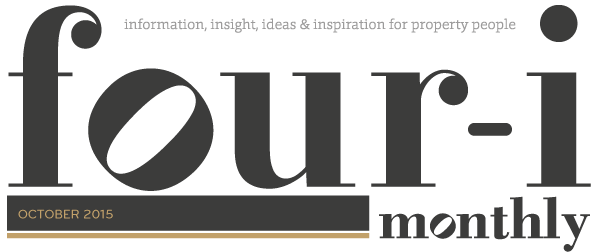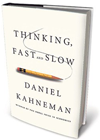

Thinking Fast and Slow – Daniel Kahneman
by Annie Gray
How and why do we make the choices we do?
Why after you’ve heard a lie repeatedly do you start to believe it?
Why are you more likely to accept a suggestion after you yourself have made an error?
Why does 35mph feel so fast after you’ve been driving at 10mph and so slow after you’ve been driving at 70mph?
And, why does buying a house for £250,000 feel cheap if the asking price was £280,000 and expensive if it had originally been £220,000?
Daniel Kahneman cleverly engages the reader in Thinking Fast and Slow using a combination of real life scenarios and exercises. This engagement deeply challenges the reader’s understanding of the way in which they use their brain and causes a real change in the way in which they see themselves.
In terms of reviewing or creating a summarising Thinking Fast and Slow it is somewhat challenging, the book is an ‘information journey’. I have therefore attempted to link together some of the main ideas and theory within the book to create a simple take away of the concepts. I do feel that in order to enjoy the level of engagement and rich thinking that is within the book – it is best read in full.
The book begins with an explanation of what Kahneman calls ‘System 1’ and ‘System 2’. System 1 and 2 are not biologically separate parts of our brain but instead the way in which Kahneman presents his findings. He does this to enable the reader to understand how the two different parts operate. It allows you to think of them as two separate but ultimately, complementary systems.
System 1 – thinking fast – requires no thought; automatic, effortless reaction based on what is already ingrained in our brains. Examples of such include completing the sentence ‘bread and …’ or driving a car on an open road. It is free for us to use as it requires no ‘thought spend’, it requires no conscious effort and we cannot turn it off. System 1 operates like a “mental shotgun” we evaluate and make decisions without taking time to work out which of the variables are most important.
System 2 is the slow one; it requires consideration and time to engage our thought process. We use system 2 to solve problems or complete activities that require concentration such as parking in a tight space.
System 1 produces immediate findings for our system 2 to interpret and react to, in the instances where a reaction is required. Our systems interact daily to alter the way in which we react. Problems occur with this when our system 1 kicks into action based on what Kahneman calls ‘heuristics’ (things which we assume automatically), particularly so when these heuristics are not accurate.
System 2’s effectiveness can also be impaired: mental calculations, tiredness and alcohol can distract system 2 and reduce its effectiveness. This is why willpower is reduced when someone is tired (mentally or physically), hungry or has had alcohol. Kahneman also states that people are more likely to make selfish decisions or superficial judgements when they are ‘cognitively busy’. I’m sure everyone reading this can think of an instance when they have reacted in a less desirable way – when stressed, hungry or over tired – an example of Kahneman’s theory at play.
We as humans prefer to think fast and use system 1, it requires less time and effort. Therefore, we have a tendency to use it for activities that are routine, and only use system 2 when we have or want to. When we do engage system 2 we find we become immersed in it, hence why self-control becomes difficult when we are stressed and tired and frustrating when interrupted if concentrating.
The perfect combination occurs when you unite the two – the basis of intelligence. Kahneman describes; ‘Intelligence is not only the ability to reason; it is also the ability to find relevant material in memory and to deploy attention when needed.’ Reducing the time in which you need to spend engaged in deep thought and enabling you to quickly access relevant material, so you make better decisions, faster with a lesser thought effort.
Kahneman explains why humans struggle to think statistically through his explanation and examples of heuristics. Demonstrating how system 1 associates new information and learning with existing, patterns, thoughts and behaviours. This also links with why we become naturally biased.
The availability heuristic, for example, is a shortcut we make it our minds to make judgements about likely outcomes, based on the ease of which we can think of examples. In other words, the easier it is to recall the consequences of something, the greater we perceive these consequences to be. Sometimes, this heuristic is beneficial, but the frequencies that events come to mind are usually not accurate reflections of the probabilities of such events in real life.
One of the great advantages of system 1 is that it allows us to continuously, and efficiently, react and engage with the world around us as we go about our day-to-day routine. Without it there would be a constant delay between a stigma and our reaction. We are creatures of habits and as Kahneman explains, our heuristics encourage us to continuously look for patterns. We jump to conclusions and let regularity alter the way in which we make decisions and ultimately our judgements.
A further heuristic Kahneman explains is Representativeness; a cognitive shortcut whereby we let how well our expectations of a scenario affect how likely the situation is to be true. The classic ‘to judge a book by a cover’ falls into this – we measure the likeliness of our enjoying a book based on its exterior.
This is linked to the confirmation bias whereby we interpret new information based on our initial hypothesis. Supported by the saying ‘we believe what we want to’, whilst in our minds we recognise this isn’t best practice, or fair it is a habit which is ingrained into our being. Kahneman even states of himself, after forty years studying heuristics and biases: “My intuitive thinking is just as prone to [heuristics and biases] as it was before I made a study of these issues. I have improved only in my ability to recognise situations in which errors are likely.” (p.417).
The best way for us to deal with this is to listen and ask for feedback so we can educate ourselves in the way in which we have reacted to a situation. We are tend to be risk-averse when making decisions so receiving this level of feedback improves our decision making process.
Kahneman links the way in which we make decisions to his Prospect theory. Prospect theory is Kahneman’s main claim to fame; it was for this he received his Nobel Prize. Based on errors he noticed in Daniel Bernoulli’s utility theory, that only logical assumptions surround economic rationality), Kahneman recognised that the value of money is subject to behavioural biases.
The theory is based around 3 main concepts 1) a £500 loss or gain can be psychologically positive or negative dependant on the initial reference point or how much money someone currently has, 2) our sensitivity to losing money diminishes as we have more 3) we hate the concept of losing money and will spend to reduce loss.
Our belief in probability is also altered as percentage odds increase – an increase from 90 – 100% (certainty) seems more impactful than the increase of 30-40%. However, most impactful is the change from 0 – 10%, the instance of something becoming possible and eliminating the chance of a certain loss.
Kahneman introduces the concept he labels What You See Is All There Is (WYSIATI). This theory states that when the mind makes decisions, it deals primarily with what it knows, phenomena it has already observed. Rarely considering what are known as unknowns, phenomena that it knows to be relevant but about which it has no information, and with little or no acknowledgement of what it doesn’t know. He explains that humans fail to take into account complexity and that their understanding of the world consists of a small and necessarily unrepresentative set of observations. The mind generally does not account for the role of chance; and therefore, falsely assumes that a future event will mirror a past event of which it has experience.
Kahneman continues and explores a great range of heuristics: theory induced blindness, the hindsight illusion, the expectation principle etc. to examine the way our pre-set belief and understandings alter the way in which we use our brains and allow our two systems to interact.
All of which links to framing; and the way we ‘frame’ a challenge or opportunity, based on our heuristics. This greatly alters our choices more so than rational considerations would imply. A survival rate of 90% is viewed as more positive than a mortality rate of 10% – both mean the same thing. However, as survival has a higher emotional value than mortality our system 1 allows us to see it as having a different meaning. In order to reframe something we have to engage our system and expend energy and ultimately system 2 is lazy.
We therefore, as humans can be known to seek:
– diminishing returns
– risk aversion
– points of reference we believe to matter
Which when we understand the basis of each we are able to greater engage with the way in which our brains work. Kahneman surmises this; “the attentive System 2 is who we think we are. System 2 articulates judgments and makes choices, but often endorses or rationalises ideas and feelings that were generated by System 1” (p.415).
For anyone who is interested in the way in which our brains work and the decisions that we make, Thinking Fast and Slow is a wonderful read. The book has great examples, which really allow you to think about the ideas and concepts underpinning Kahneman’s philosophy. I very much hope anyone who chooses to read it following this enjoys it as I did, and look forward to discussing it with anyone who would like to.
![]()